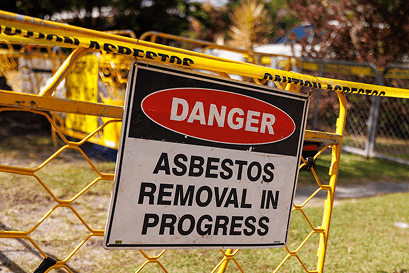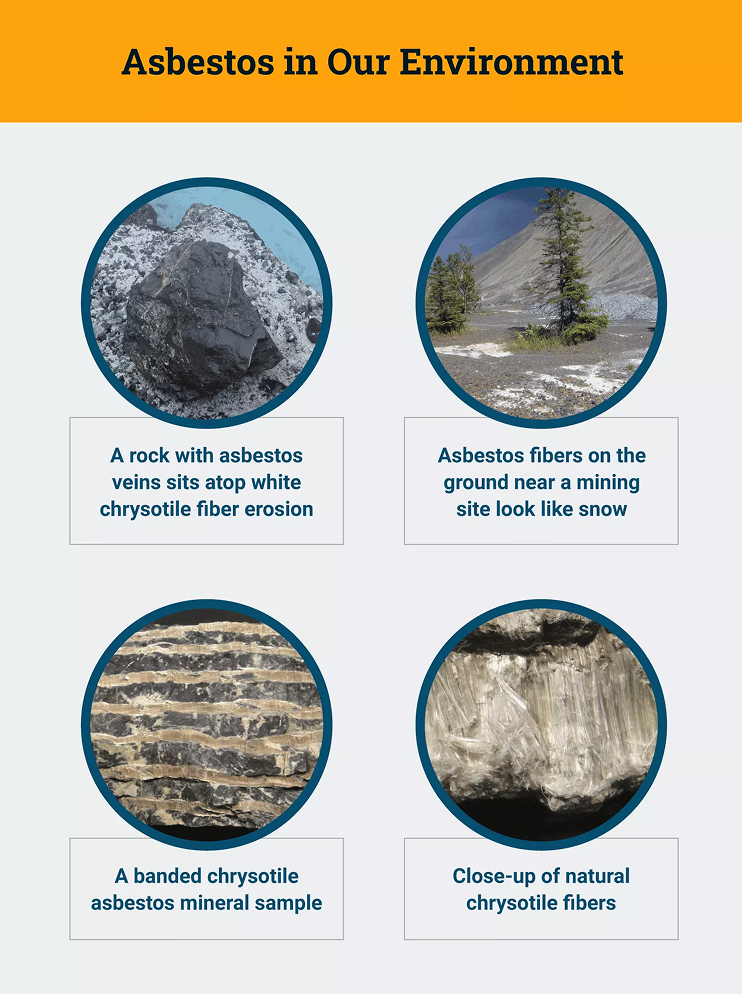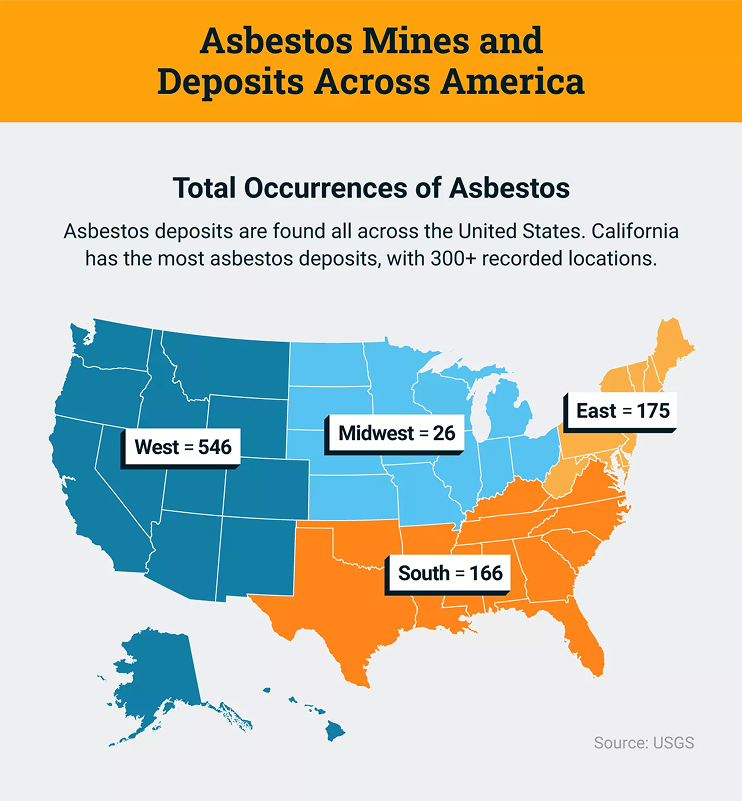Environmental Effects of Asbestos
Asbestos fibers released through human activities and natural disasters can contaminate the air, water and soil. The environmental effects of asbestos can contribute to human health effects like mesothelioma. Remediation efforts aim to protect people from exposure to environmental asbestos exposure.

How Does Asbestos Affect the Environment?
The environmental effects of asbestos can harm humans, wildlife and possibly plant life. Activities like mining, construction and even natural disasters can release asbestos fibers into the air, water and soil. Even though asbestos is a mineral that forms naturally in mountainous areas, it can cause problems when it’s released into the environment.
When people breathe in asbestos fibers, they can get trapped in and around their lungs, leading to serious human health effects like mesothelioma. Asbestos fibers can also harm wildlife and pets. Scientists have found evidence of mesothelioma in animals exposed to asbestos including dogs, cats, fish and cows.
Studies on how asbestos affects plants have shown mixed results. Some plants seem to be more resistant to asbestos than others. Heavy metals often contaminate the soil alongside asbestos, making it difficult for scientists to determine the effects of asbestos alone. Researchers are investigating ways to use plants in soil remediation efforts. This phytoremediation has the potential to stabilize asbestos in soil to limit human exposure.

Air Pollution & Asbestos Exposure
Asbestos air pollution can cause serious human health effects. Activities like asbestos mining and construction on land with asbestos deposits can release these fibers into the air. Once airborne, the fibers can travel long distances, affecting the environment and the people and animals that live there.
Natural disasters like hurricanes and tornadoes can damage buildings that contain asbestos, also causing air pollution. When asbestos becomes damaged, fibers are released into the air. Similarly, man-made disasters like fires and demolitions can release asbestos fibers. These airborne fibers pose a serious threat to the environment.
Wind can carry them to different areas, contaminating the air, water and soil. When people and wildlife inhale these fibers, they can become trapped in the lungs, leading to serious health problems.
Soil and Water Contamination
Soil and water contamination with asbestos happens when tiny asbestos fibers spread into the ground and water. Natural sources of asbestos, like ultramafic rocks containing asbestos, can break down over time. Wind and rain can carry these fibers into the soil and water, contaminating them.
Construction and other human activities can also disturb natural asbestos. When people dig or move soil with asbestos, the fibers can break away and spread. Rain can then wash these fibers into rivers, lakes and groundwater supplies. This makes the water unsafe to drink.
Asbestos-containing materials can also contaminate the environment. Old asbestos waste piles near former mines and factories can release fibers. Asbestos in landfills can also contaminate the soil and water. Some Superfund sites have a history of extensive asbestos contamination. A Superfund site is a polluted location that the government has identified for remediation efforts because it poses a risk to human health and the environment.

Gain access to top mesothelioma doctors and get help scheduling appointments.
Connect NowWho Is at Risk of Environmental Asbestos Exposure?
People who live near asbestos deposits and mines face the greatest risk of environmental asbestos exposure. Miners and construction workers who disturb asbestos deposits can breathe in the fibers. Natural disasters like wildfires and floods can also disturb asbestos and put people at risk.
Children and pets can be at risk if they play in areas with asbestos-contaminated soil. Children face heightened risks if exposed because their lungs are still developing. Their young age offers time for asbestos to damage their health. Asbestos-related health issues take approximately 20-60 years to develop.
Asbestos is found in low levels in air, water or soil nationwide. This means that everyone is exposed during their lifetime. Most people remain healthy with limited exposure.
It is important to know where asbestos is in the environment so that future urban development does not encroach on it, and we can prevent cancer in the future.
Asbestos in the United States
Naturally occurring asbestos deposits are in many areas of the United States. Mountainous regions have the most deposits. The Western U.S. was home to mining operations in California, Montana, Nevada, Wyoming, Idaho and Washington. The U.S. Geological Survey has created an interactive map you can use to see if there are natural asbestos deposits near you.
The U.S. stopped mining asbestos in 2002. Even though the U.S. no longer mines asbestos, it still imports it. In 2023, the U.S. consumed 150 metric tons of asbestos, according to the U.S. Geological Survey.
The U.S. Environmental Protection Agency announced a ban on chrysotile asbestos in 2022. The ban includes timelines for phasing out asbestos in different industries. For example, the chlor-alkali industry has up to 12 years to find alternatives to asbestos.

Case Study: Las Vegas, Nevada
Environmental exposure to asbestos in the Clark and Nye counties in southern Nevada is largely the result of development. Researchers from the University of Hawaii Cancer Center found high rates of mesothelioma among women and young people in the area in 2015.
The mix of construction growth, off-road recreational vehicle usage, dust storms and a dry climate allowed asbestos to become airborne and blow into the Las Vegas area. This area is home to 1.9 million people.
Many residents live close to or downwind from natural asbestos sources. A 2019 study showed ongoing development and population growth increase the risk of exposure.
Case Study: Libby, Montana
Mining in Libby, Montana, contaminated the land, water and air with asbestos. Environmental contamination spread at least 20 miles away into the town of Troy. Scientists found asbestos in the bark of trees within the forests surrounding the Libby mine.
A 2021 study reports around 700 people have died from asbestos-related diseases in Libby. About 2,400 additional residents have received a related diagnosis.
The mine closed in 1990, and cleanup didn’t begin until 1999. The EPA removed more than a million cubic yards of hazardous materials. This made it the largest asbestos cleanup in U.S. history.
The Long-Term Environmental Impact of Asbestos
Mining, using and dumping asbestos can contaminate the environment for a long time. Wind and rain spread asbestos fibers. These fibers can affect wildlife in addition to humans.
Long-Range Asbestos Effects on the Environment
- Animals breathe in asbestos fibers and can get sick.
- Humans develop diseases decades after exposure to environmental asbestos.
- Plants may experience effects from asbestos in the soil.
- Soil and water remain contaminated for a long time because asbestos is durable.
Asbestos contamination from the past still affects the environment today. Old mines and factories leave behind asbestos. This contamination affects the future of land use and puts nearby residents at risk. Remediation efforts try to clean these areas with varying degrees of success.
Ways to Limit Environmental Asbestos Exposure
People can take measures to protect themselves from environmental asbestos exposure. They can learn about asbestos risks in their area. People who live near areas with asbestos in the soil should avoid disturbing it.
Tips to Reduce Environmental Asbestos Exposure Risks
- Check the U.S. Geological Survey interactive map for asbestos deposits near you.
- Learn about asbestos Superfund sites in your area.
- Avoid disturbing soil or dust near old mines or asbestos factories.
- Don’t dig or garden in areas known to contain asbestos in the soil.
- Clean shoes before entering your home if you live near asbestos deposits.
Hotspots like El Dorado Hills, California, have environmental asbestos exposure risks. You can learn about asbestos exposure risks per state. Hiring licensed abatement professionals to remove asbestos safely can protect your family from exposure.
Common Questions About How Asbestos Affects the Environment
- Why is asbestos an environmental issue?
-
Asbestos is an environmental issue because it can pollute the air, soil and water. Asbestos fibers cause serious health problems in humans and wildlife. Toxic exposure to environmental asbestos causes mesothelioma in humans and animals.
- Where is asbestos most commonly found in the environment?
-
Asbestos in the environment is mostly found near mountainous regions. Natural asbestos deposits and old mining sites present a serious risk of exposure.
- Can natural disasters contaminate the environment with asbestos?
-
Yes, natural disasters like hurricanes and earthquakes can lead to asbestos contamination in the environment. They can damage natural asbestos deposits and destroy buildings with asbestos. This damage releases asbestos fibers into the air.
- Can asbestos contamination in the environment be cleaned up?
-
Yes, remediation efforts can clean up asbestos contamination in the environment. Methods exist to remove asbestos from soil and water. For example, if asbestos is in a top layer of soil, workers carefully dig it up and take it to a designated disposal site. Removing asbestos from water involves filters and special treatments. In the future, the cost of denaturing asbestos with extremely high heat may become more affordable and more widely available.




